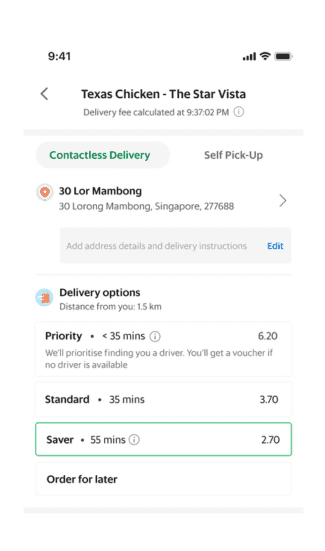Consumers on GrabFood using the lower cost Saver delivery option have racked up over US$17.4 million in savings this year across the region, according to our data as at August.
The Saver food delivery option offers consumers a lower delivery charge, in exchange for a longer delivery time. This is targeted at those who are willing to wait a little longer for their meals. Delivery-partners, on the other hand, can boost earnings by getting the opportunity to complete more orders with less time and effort.

Since the pandemic, more consumers have become accustomed to getting food sent to their doorsteps. And this habit stuck. Our 2022 Food Trends report found that about 70 per cent of consumers in Southeast Asia view delivery as a permanent part of their post-pandemic lives.
(Read more: How the ‘Saver’ option for food deliveries works)
So we set out to make such a convenience even more accessible. We did this by rolling out differently priced tiers of delivery fees, to appeal to a wider range of consumers.
We first launched the Saver option in Singapore last year and subsequently in select cities across Indonesia, Philippines, Malaysia, Thailand, and Vietnam.
The longer wait time from Saver delivery is the result of batching—delivery-partners will pick up two or more orders in one trip and have them delivered to consumers along the same route. As such, our delivery-partners can pick up and send more orders in one go, and in return, the consumer enjoys lower delivery fees.
Users are big fans of Saver
Grab completed about 80 per cent more Saver deliveries in August 2023 compared to March 2023. This was partly attributed to the launch of Saver delivery across more cities from March onwards.
Despite the longer wait times, a large majority of consumers were satisfied with their orders. Among orders that were reviewed by consumers, at least 96 per cent received a 5-star driver rating across the region.
People are placing their orders ahead of lunch.
Consumers also account for the longer waiting time by placing their orders ahead of lunch. Across the region, most Saver orders came in between 10am and 12pm.
Saver was the most popular in Malaysia, based on the proportion of users who opted for Saver.
This is followed by Singapore and the Philippines.

Those in the Philippines were willing to wait for their fast food. Among the most popular food items found in Saver orders were fried chicken, burgers and spaghetti from local fast food chain Jollibee.
Elsewhere, local food items such as nasi goreng (fried rice) and prata topped the charts. Meanwhile, consumers in Vietnam often topped their meal off with drinks such as Coca-cola, coffee and kumquat tea.
3 Media Close,
Singapore 138498
Komsan Chiyadis
GrabFood delivery-partner, Thailand
COVID-19 has dealt an unprecedented blow to the tourism industry, affecting the livelihoods of millions of workers. One of them was Komsan, an assistant chef in a luxury hotel based in the Srinakarin area.
As the number of tourists at the hotel plunged, he decided to sign up as a GrabFood delivery-partner to earn an alternative income. Soon after, the hotel ceased operations.
Komsan has viewed this change through an optimistic lens, calling it the perfect opportunity for him to embark on a fresh journey after his previous job. Aside from GrabFood deliveries, he now also picks up GrabExpress jobs. It can get tiring, having to shuttle between different locations, but Komsan finds it exciting. And mostly, he’s glad to get his income back on track.

